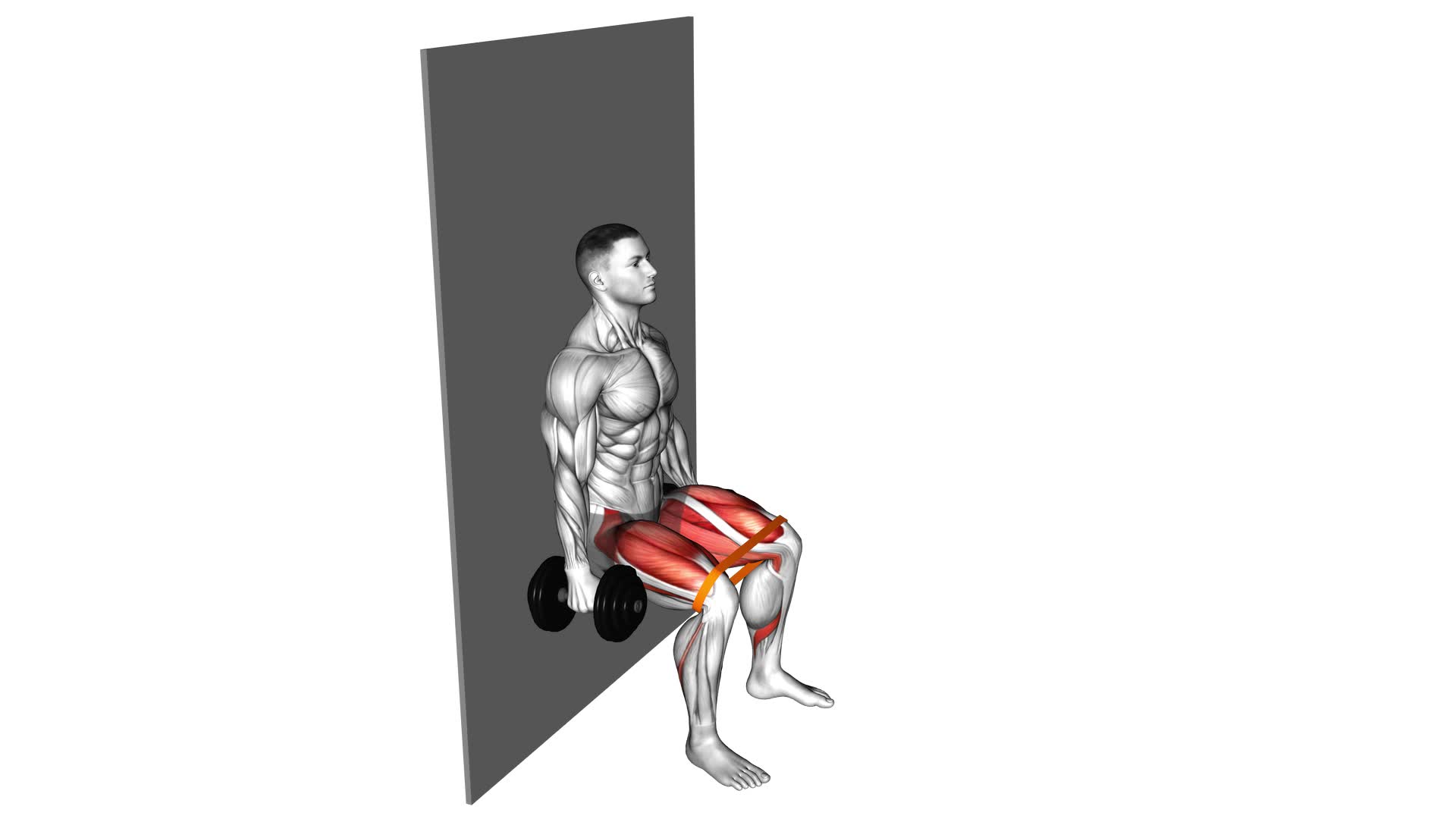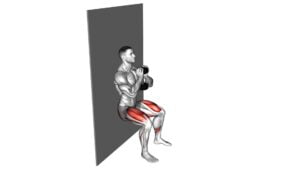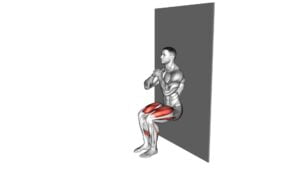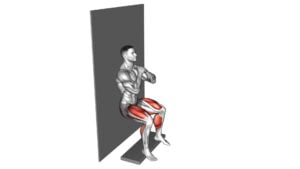Dumbbell Banded Wall Sit (male) – Video Exercise Guide & Tips

Are you looking for a challenging exercise that targets your legs and core? Look no further than the dumbbell banded wall sit!
Watch This Exercise Video
This exercise guide and video will show you step-by-step how to perform this effective move.
With the added resistance of the band and the weight of the dumbbell, you'll be able to push your muscles to the limit.
Get ready to feel the burn and see results with this intense workout.
Key Takeaways
- The Dumbbell Banded Wall Sit targets leg muscles for improved leg strength.
- Incorporating dumbbells adds resistance and muscle challenge to the exercise.
- Engaging core muscles enhances stability and posture during the exercise.
- Resistance bands provide added resistance and target lower body muscles for increased stability and activation.
Benefits of the Dumbbell Banded Wall Sit
To fully understand the benefits of the Dumbbell Banded Wall Sit, it's important for you to know how this exercise can improve your strength and stability.
The Dumbbell Banded Wall Sit is a powerful exercise that targets your leg muscles, helping you to develop improved leg strength. By incorporating dumbbells into the exercise, you add resistance that challenges your leg muscles even further, leading to greater gains in strength.
The banded aspect of this exercise also enhances stability by engaging your core and forcing you to maintain proper posture throughout the movement. As you lower yourself into the wall sit position, the resistance from the bands intensifies, activating your muscles and promoting increased stability.
The Dumbbell Banded Wall Sit is a versatile exercise that can benefit anyone looking to strengthen their legs and improve stability. Whether you're an athlete looking to enhance your performance or someone simply seeking to build stronger legs, this exercise is a valuable addition to your workout routine.
Equipment Needed for the Exercise
To perform the Dumbbell Banded Wall Sit exercise, you'll need a few pieces of equipment. Here are the items you'll need:
- Resistance Bands: These elastic bands provide added resistance to intensify the wall sit exercise. They're excellent for targeting and strengthening the muscles in your lower body, including your quadriceps, hamstrings, and glutes. Using resistance bands can help improve muscle strength, endurance, and flexibility.
- Dumbbells: Dumbbells are optional but can be used to add an extra challenge to the exercise. By holding dumbbells in your hands while performing the wall sit, you can increase the resistance and further engage your upper body muscles, such as your biceps and shoulders.
- Wall: Find a sturdy wall or surface to lean against during the exercise. Make sure it's smooth and free from any obstructions or sharp edges.
- Exercise Mat: While not necessary, an exercise mat can provide additional comfort and support for your back and knees during the wall sit. It can help reduce any discomfort or pressure on these areas, making the exercise more enjoyable.
If you don't have access to resistance bands or dumbbells, you can still perform alternative exercises without equipment. Some options include bodyweight squats, lunges, or standing wall sits. These exercises can effectively target and strengthen your lower body muscles without the need for any additional equipment.
Proper Form and Technique
Sit with your back against the wall, feet shoulder-width apart, and knees bent at a 90-degree angle. This is the starting position for the dumbbell banded wall sit exercise. To ensure proper form and technique, there are a few key points to keep in mind.
First, avoid leaning forward or rounding your back. Engage your core muscles to maintain an upright position and prevent strain on your lower back. Keep your shoulders relaxed and your chest lifted throughout the exercise.
Next, make sure your knees are directly above your ankles. Avoid letting your knees extend past your toes, as this can place excessive stress on your knee joints. Maintain a 90-degree angle in your knees throughout the movement.
Another common mistake isn't using proper breathing technique. Remember to inhale deeply before lowering into the squat position, and exhale as you push through your heels to return to the starting position. This will help stabilize your core and provide more power during the exercise.
The muscles targeted in this exercise include the quadriceps, hamstrings, glutes, and calves. By maintaining the correct form and technique, you can effectively engage and strengthen these muscle groups. Remember to start with light dumbbells and gradually increase the weight as you become more comfortable with the exercise.
Variations to Increase the Difficulty
To make the dumbbell banded wall sit exercise more challenging, you can incorporate variations that target different muscle groups or increase the intensity of the movement. Here are four progression options to consider:
- Single-leg wall sit: Instead of using both legs, try doing the wall sit with only one leg. This variation increases the demand on your quads and glutes, as well as your balance and stability.
- Banded wall sit with overhead press: Attach a resistance band to the wall in front of you and hold the ends of the band in your hands. As you perform the wall sit, simultaneously press the dumbbells overhead. This variation adds an upper body component to the exercise, targeting your shoulders, triceps, and core.
- Dumbbell banded wall sit with lateral raises: With the resistance band still attached to the wall, hold the ends of the band in your hands and perform lateral raises as you maintain the wall sit position. This variation engages your shoulders, specifically targeting the medial deltoids.
- Dumbbell banded wall sit with bicep curls: Attach the resistance band to the wall and hold the ends of the band in your hands. As you perform the wall sit, curl the dumbbells towards your shoulders. This variation adds an extra challenge for your biceps and forearms.
Tips for Getting the Most Out of Your Workout
To maximize your workout and achieve optimal results, follow these tips for getting the most out of your dumbbell banded wall sit exercise.
First and foremost, focus on your form. Proper form is crucial for workout efficiency and maximizing results. Make sure your back is flat against the wall, your knees are at a 90-degree angle, and your feet are shoulder-width apart. Engage your core and squeeze your glutes throughout the exercise to activate the correct muscles.
Next, pay attention to your breathing. Taking deep breaths and exhaling slowly can help you maintain control and stability during the wall sit. Inhale deeply as you lower yourself into the seated position, and exhale slowly as you push through your heels to stand back up. This controlled breathing technique can enhance your workout and improve your overall performance.
Additionally, consider incorporating resistance bands into your wall sit routine. Using bands adds an extra challenge and targets your muscles in different ways. Attach the bands around your thighs, just above your knees, and feel the burn as you push against the resistance. This simple addition can increase the intensity of your workout and maximize your results.
Lastly, remember to listen to your body. Push yourself, but don't overdo it. If you experience pain or discomfort, take a break and modify the exercise as needed. It's important to find the right balance between challenging yourself and avoiding injury.
Frequently Asked Questions
How Many Sets and Repetitions Should I Do for the Dumbbell Banded Wall Sit Exercise?
To determine the number of sets and repetitions for the dumbbell banded wall sit exercise, consider your workout intensity and goals.
Start with 2-3 sets of 10-15 repetitions, focusing on proper form and engaging your leg muscles.
As you progress, you can increase the number of sets or repetitions.
You can also add variations and modifications like using heavier dumbbells or adjusting the band tension to make the exercise more challenging.
Remember to listen to your body and adjust accordingly.
Can Beginners Perform the Dumbbell Banded Wall Sit Exercise?
Yes, beginners can perform the dumbbell banded wall sit exercise. It's a great exercise for strength training, especially for your lower body.
To modify it for beginners, you can start by using a lighter dumbbell or no dumbbell at all. The banded wall sit helps improve leg strength and stability, targeting your quads, glutes, and hamstrings.
Make sure to maintain proper form and gradually increase the intensity as you progress.
How Long Should I Hold the Wall Sit Position?
To get the ideal duration for holding the wall sit position, you need to consider your fitness level and goals. Beginners can start with 20-30 seconds and gradually increase as they get stronger. Advanced lifters can aim for 1-2 minutes or even longer.
Holding the wall sit position activates your quads, glutes, and core, helping to build strength and endurance. It also improves lower body stability and can be a great addition to your leg day routine.
Can the Dumbbell Banded Wall Sit Exercise Help With Weight Loss?
The dumbbell banded wall sit exercise can be beneficial for weight loss. By incorporating dumbbells and resistance bands, you're adding an extra challenge to the exercise, which can help increase muscle strength and burn more calories.
This exercise targets multiple muscle groups, including the legs, glutes, and core, making it an effective full-body workout. Additionally, there are variations of this exercise that you can try to keep your routine interesting and continue to challenge your body.
Are There Any Potential Risks or Injuries Associated With the Dumbbell Banded Wall Sit Exercise?
When performing the dumbbell banded wall sit exercise, it's important to be aware of potential risks and injuries. To minimize the risk of injury, make sure to use proper form and technique. Avoid leaning too far forward or placing excessive strain on your knees.
Also, be cautious of using too heavy of a weight, as this can increase the risk of injury. Always warm up before starting the exercise and incorporate cool down stretches afterwards to prevent muscle strains.
Conclusion
In conclusion, the dumbbell banded wall sit is a highly effective exercise for strengthening your lower body muscles and improving overall stability. By incorporating dumbbells and resistance bands, you can increase the intensity of this exercise and challenge your muscles even further.
Remember to maintain proper form and technique throughout the exercise to maximize results and prevent injuries. By following these tips and variations, you can make the most out of your dumbbell banded wall sit workout and achieve your fitness goals.

Author
Years ago, the spark of my life’s passion ignited in my mind the moment I stepped into the local gym for the first time. The inaugural bead of perspiration, the initial endeavor, the very first surge of endorphins, and a sense of pride that washed over me post-workout marked the beginning of my deep-seated interest in strength sports, fitness, and sports nutrition. This very curiosity blossomed rapidly into a profound fascination, propelling me to earn a Master’s degree in Physical Education from the Academy of Physical Education in Krakow, followed by a Sports Manager diploma from the Jagiellonian University. My journey of growth led me to gain more specialized qualifications, such as being a certified personal trainer with a focus on sports dietetics, a lifeguard, and an instructor for wellness and corrective gymnastics. Theoretical knowledge paired seamlessly with practical experience, reinforcing my belief that the transformation of individuals under my guidance was also a reflection of my personal growth. This belief holds true even today. Each day, I strive to push the boundaries and explore new realms. These realms gently elevate me to greater heights. The unique combination of passion for my field and the continuous quest for growth fuels my drive to break new ground.







